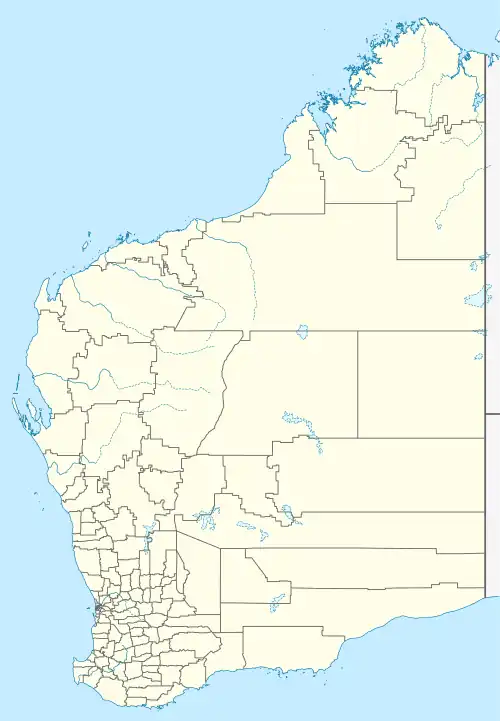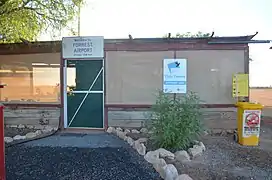Forrest, Western Australia
Forrest is a former small railway settlement and stopping place on the Nullarbor Plain, 245 kilometres (152 miles) west of the Western Australia / South Australia state border, established in 1916 during construction of the Trans-Australian Railway. It is on the part of the railway that is the longest – at 478.193 kilometres (297.135 miles) – stretch of straight railway line in the world.[note 1] In the 2021 census, the settlement and surrounding area had "no people or a very low population".[3][4]: 214
| Forrest Western Australia | |||||||||||||||
|---|---|---|---|---|---|---|---|---|---|---|---|---|---|---|---|
 Fish-eye aerial view taken over Forrest, looking east, in 1986. The train is the Trans-Australian. | |||||||||||||||
 Forrest | |||||||||||||||
| Coordinates | 30°50′53″S 128°06′32″E | ||||||||||||||
| Population | 3 (SAL 2021)[1] | ||||||||||||||
| Postcode(s) | 6434 | ||||||||||||||
| Area | 31,639.1 km2 (12,215.9 sq mi) | ||||||||||||||
| State electorate(s) | Kalgoorlie | ||||||||||||||
| Federal division(s) | O'Connor | ||||||||||||||
| |||||||||||||||
The settlement was named after Sir John Forrest, the explorer who became the first Premier of Western Australia.[5] He was much involved in the push for Australia's federation and was the pre-eminent advocate for building the Trans-Australian Railway.[4]: 44–48
Forrest no longer functions as a minor station as it did when established to service steam locomotives and maintain track. For six decades, a succession of about a dozen railway families lived there to provide essential operational and engineering services. However, from 1951, when steam engines were replaced by diesel locomotives that did not have to stop regularly for water and were very reliable, fewer employees were needed. Later, successive engineering changes – from timber to concrete sleepers, introduction of continuous welded rail, and mechanisation of track maintenance – continued to reduce the need for labour. Eventually all railway facilities were demolished, except for six houses that remain available for travellers. After 1997, when the assets of Australian National Railways were sold to private operators, all maintenance of track and facilities was undertaken by non-resident contractors. The track configuration as of 2017 was a 2.6 kilometres (1.6 miles) crossing loop, a goods loop of 540 metres (590 yards) and a short camp-train siding for emergency use.[6]
The sole passenger train on the western part of the Trans-Australian Railway, the Indian Pacific experiential tourism train, does not stop there.[7]

Forrest Airport is an important stopping place on the east–west air route for refuelling aircraft with short-range flight capacity. It was established in 1929, when it was the overnight stop on the first scheduled passenger air service between Perth and Adelaide, operated by West Australian Airways from 1929 to 1934. It has been in continuous use since then. Today, the airfield consists of two sealed runways 1350 metres (1480 yards) and 1520 metres (1660 yards) long, a large aircraft parking hangar, and Avgas and Jet A1 aviation fuel refuelling points. As of 2023, nearby cottages could be booked for overnight accommodation.[8]
By road, Forrest is accessible only by unsealed tracks from the Eyre Highway at Eucla and Mundrabilla, about 110 kilometres (68 miles) to the south-east and south respectively.[9]
Climate
Forrest has a typical arid climate but it is cooler in summer than much of the Australian desert because it is 120 kilometres (75 miles) from the Southern Ocean. Despite this, as of 2021 Forrest held the record for the equal 6th-hottest temperature in Australia, 49.8 °C (121.6 °F) being recorded on 13 January 1979.[10]
| Climate data for Forrest, Australia (averages: 1993–2015; temperature extremes: 1946–2015.note: a standard 30-year data compilation period has not been used) | |||||||||||||
|---|---|---|---|---|---|---|---|---|---|---|---|---|---|
| Month | Jan | Feb | Mar | Apr | May | Jun | Jul | Aug | Sep | Oct | Nov | Dec | Year |
| Record high °C (°F) | 49.8 (121.6) |
47.5 (117.5) |
45.3 (113.5) |
40.1 (104.2) |
36.9 (98.4) |
31.3 (88.3) |
29.7 (85.5) |
34.2 (93.6) |
38.7 (101.7) |
43.3 (109.9) |
44.9 (112.8) |
49.5 (121.1) |
49.8 (121.6) |
| Average high °C (°F) | 33.2 (91.8) |
32.4 (90.3) |
29.2 (84.6) |
26.2 (79.2) |
22.3 (72.1) |
19.1 (66.4) |
18.7 (65.7) |
21.90 (71.42) |
24.5 (76.1) |
27.4 (81.3) |
30.0 (86.0) |
31.4 (88.5) |
26.36 (79.45) |
| Average low °C (°F) | 16.3 (61.3) |
16.7 (62.1) |
14.4 (57.9) |
12.0 (53.6) |
8.9 (48.0) |
6.1 (43.0) |
5.0 (41.0) |
5.8 (42.4) |
8.3 (46.9) |
10.7 (51.3) |
13.1 (55.6) |
14.8 (58.6) |
11.0 (51.8) |
| Record low °C (°F) | 6.6 (43.9) |
6.3 (43.3) |
5.7 (42.3) |
2.3 (36.1) |
−0.5 (31.1) |
−4.3 (24.3) |
−4.5 (23.9) |
−3.3 (26.1) |
−2.1 (28.2) |
0.9 (33.6) |
2.6 (36.7) |
4.6 (40.3) |
−4.5 (23.9) |
| Average rainfall mm (inches) | 25.1 (0.99) |
25.8 (1.02) |
25.2 (0.99) |
18.7 (0.74) |
18.8 (0.74) |
15.6 (0.61) |
15.8 (0.62) |
13.4 (0.53) |
16.4 (0.65) |
10.3 (0.41) |
22.8 (0.90) |
25.1 (0.99) |
233 (9.19) |
| Average rainy days | 4.4 | 3.6 | 5.4 | 5.5 | 6.4 | 7.5 | 6.5 | 4.9 | 4.3 | 4.0 | 4.5 | 4.6 | 61.6 |
| Source: Bureau of Meteorology[11][12][13] | |||||||||||||
Notes
- The "long straight" extends from about 4.0 kilometres (2.5 miles) east of Nurina in Western Australia to 11.3 kilometres (7.0 miles) east of Watson in South Australia. The end-point coordinates are 30°58′33″S 126°40′07″E and 30°28′10″S 131°37′37″E respectively.[2]
References
- Australian Bureau of Statistics (28 June 2022). "Forrest (WA) (Suburb and Locality)". Australian Census 2021 QuickStats. Retrieved 28 June 2022.
- Ramsey, John (2008). "History of the Australian National Railways Commission, part 1: 1978–1990". Proceedings of the 2008 convention. Modelling the Railways of South Australia. Adelaide.
- "Forrest (WA)". Australian Bureau of Statistics. 2022. Retrieved 8 August 2022.
- Burke, David (1991). Rails through the wilderness. Kensington NSW: University of New South Wales Press. ISBN 0868401404.
- Reed, A.W. (1973) Place Names of Australia, Sydney: A.H. & A.W. Reed, ISBN 0-589-07115-7
- Vincent, Graham (2022). "ARTC WA - SA - Vic DIN" (PDF). SA Track and Signal. G.F. Vincent. Retrieved 8 August 2022.
- "The Indian Pacific 2023 timetable". Journey Beyond Rail. 2023. Retrieved 6 August 2023.
- "Forrest Airstrip Western Australia". Country Airstrips Australia. 2022. Retrieved 7 August 2022.
- Google Earth: [-31.6752, 128.8835] and [-31.818, 128.226]
- "Official records for Australia". Daily Extremes. Bureau of Meteorology. 17 May 2021. Retrieved 25 May 2021.
- "Climate Statistics for Forrest, WA". Bureau of Meteorology. Retrieved 21 December 2015.
- "Climate Statistics for Forrest Aero, WA". Bureau of Meteorology. Retrieved 21 December 2015.
- "Highest daily maximum temperatures for Australia - 19 December 2019". bom.gov.au. Bureau of Meteorology. Retrieved 29 December 2019.